2013 Peugeot 508 Hybrid brake
[x] Cancel search: brakePage 122 of 340
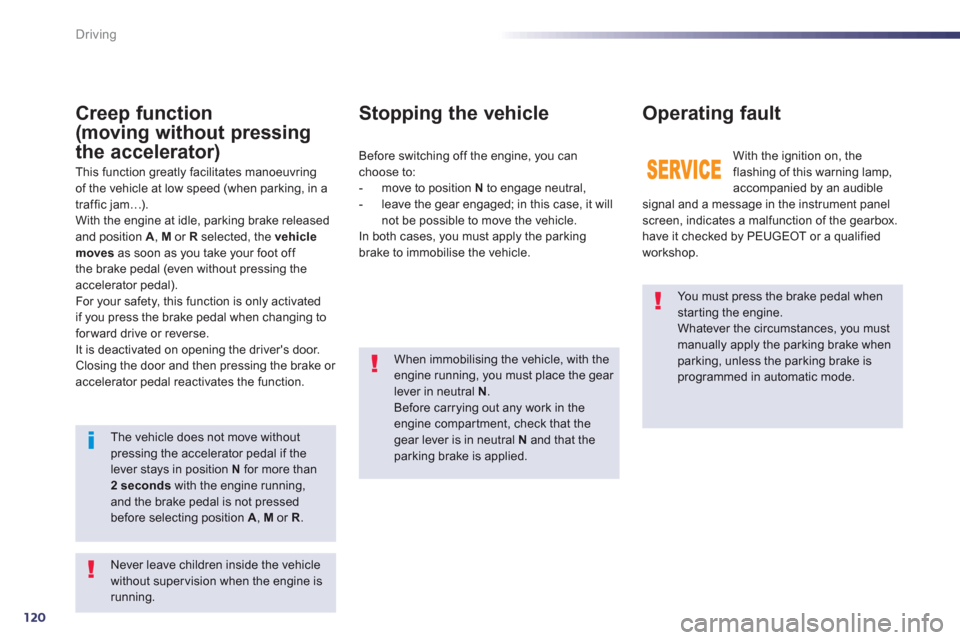
120
Driving
You must press the brake pedal when star ting the engine.
Whatever the circumstances, you must manually apply the parking brake when parking, unless the parking brake isprogrammed in automatic mode.
When immobilising the vehicle, with the engine running, you must place the gear lever in neutral N.Before carrying out any work in the engine compar tment, check that the
gear lever is in neutral N
and that the parking brake is applied.
Stopping the vehicle
With the ignition on, theflashing of this warning lamp, accompanied by an audiblesignal and a message in the instrument panelscreen, indicates a malfunction of the gearbox.
have it checked by PEUGEOT or a qualified
workshop. Be
fore switching off the engine, you can
choose to:
- move to position N
to engage neutral,
- leave the gear engaged; in this case, it will
not be possible to move the vehicle.
In both cases,
you must apply the parking brake to immobilise the vehicle.
Operating fault Creep function
(moving without pressing
the accelerator)
This function greatly facilitates manoeuvringof the vehicle at low speed (when parking, in a
traffic jam…).
With the engine at idle, parking brake released
and position A , M
or Rselected, the vehicle moves
as soon as you take your foot off
the brake pedal (even without pressing the accelerator pedal).
For your safety, this function is only activated
if you press the brake pedal when changing to forward drive or reverse. It is deactivated on opening the driver's door. Closing the door and then pressing the brake or accelerator pedal reactivates the function.
The vehicle does not move without pressing the accelerator pedal if the lever stays in position Nfor more than2 seconds
with the engine running,and the brake pedal is not pressed before selecting position A, M
or R
.
Never leave children inside the vehicle without supervision when the engine is running.
Page 123 of 340
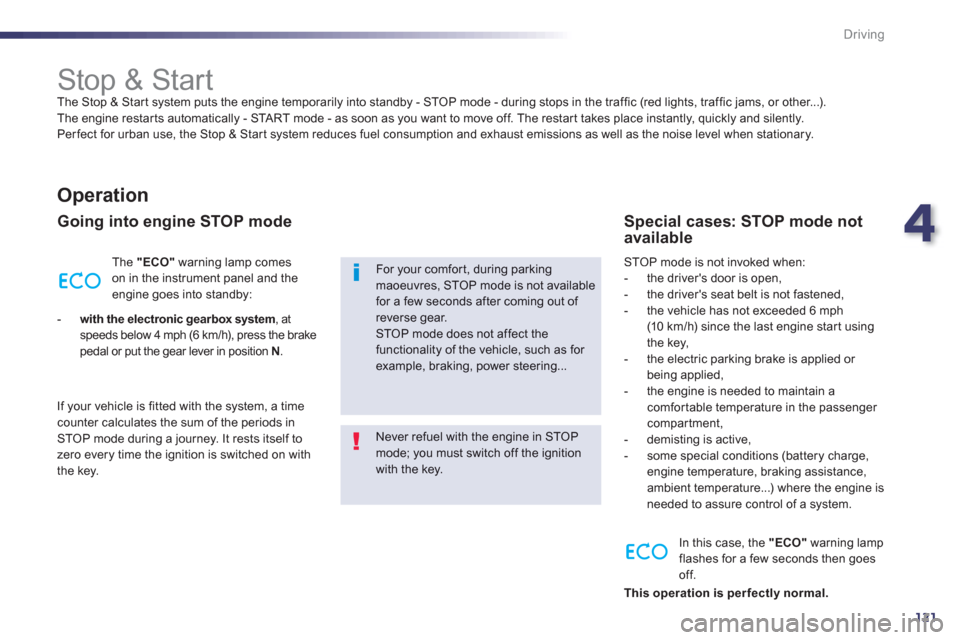
4
121
Driving
Stop & Start
The Stop & Star t system puts the engine temporarily into standby - STOP mode - during stops in the traffic (red lights, traffic jams, or other...).
The engine restar ts automatically - START mode - as soon as you want to move off. The restart takes place instantly, quickly and silently.
Per fect for urban use, the Stop & Star t system reduces fuel consumption and exhaust emissions as well as the noise level when stationary.
Operation
Going into engine STOP mode
The "ECO"warning lamp comes
on in the instrument panel and the
engine goes into standby:
-
with the electronic gearbox system, at speeds below 4 mph (6 km/h), press the brakepedal or put the gear lever in position N.
I
f your vehicle is fitted with the system, a timecounter calculates the sum of the periods in
STOP mode during a journey. It rests itself to
zero every time the ignition is switched on with
the ke
y.
Never refuel with the engine in STOPmode; you must switch off the ignition with the key.
For your comfort, during parking maoeuvres, STOP mode is not available for a few seconds after coming out of reverse gear. STOP mode does not affect the functionality of the vehicle, such as for example, braking, power steering...
Special cases: STOP mode notavailable
STOP mode is not invoked when:
- the driver's door is open,
- the driver's seat belt is not fastened,
- the vehicle has not exceeded 6 mph (10 km/h) since the last engine star t using
the key,
- the electric parking brake is applied or
being applied,
- the engine is needed to maintain acomfor table temperature in the passenger compartment,
- demisting is active,
- some special conditions (battery charge, engine temperature, braking assistance,
ambient temperature...) where the engine isneeded to assure control of a system.
In this case, the
"ECO"
warning lamp
flashes for a few seconds then goesoff.
This operation is per fectly normal
.
Page 124 of 340
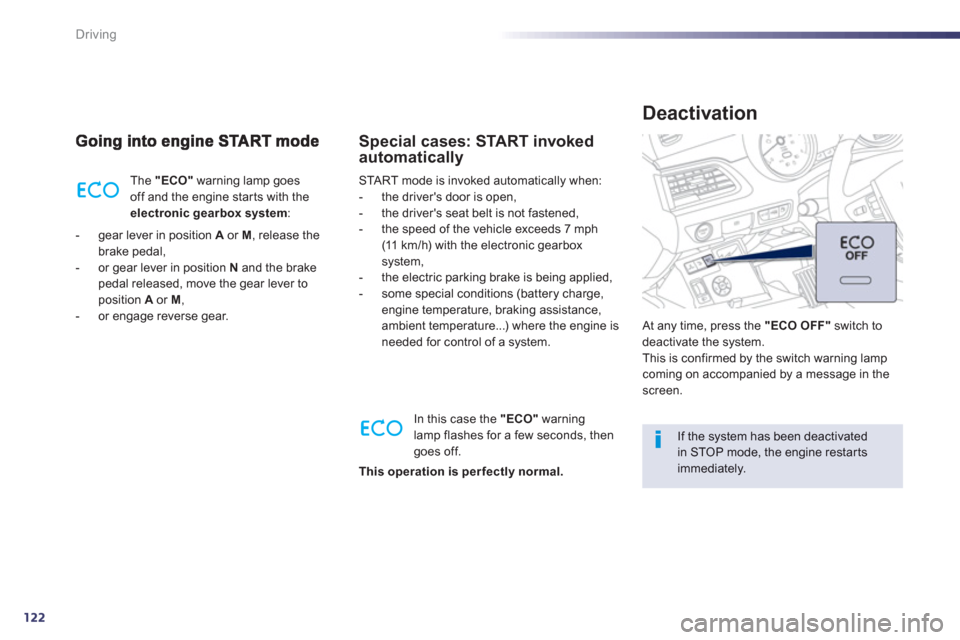
122
Driving
The "ECO"warning lamp goes
off and the engine star ts with the electronic gearboxsystem:
- gear lever in position Aor M
, release the
brake pedal,
- or
gear lever in position Nand the brake pedal released, move the gear lever toposition A
or M,- or engage reverse gear.
START mode is invoked automaticall
y when:
- the driver's door is open,
- the driver's seat belt is not fastened,
- the speed of the vehicle exceeds 7 mph(11 k m/h) with the electronic gearbox system,
- the electric parking brake is being applied,
- some special conditions (battery charge,engine temperature, braking assistance,
ambient temperature...) where the engine is
needed for control of a system.
Special cases: START invoked
automatically
In this case the "ECO"warning
lamp flashes for a few seconds, then goes off.
If the system has been deactivatedin STOP mode, the engine restartsimmediately.
At any time, press the "ECO OFF"
switch todeactivate the system.
This is confirmed by the switch warning lampcoming on accompanied by a message in the screen.
Deactivation
This operation is per fectly normal.
Page 126 of 340
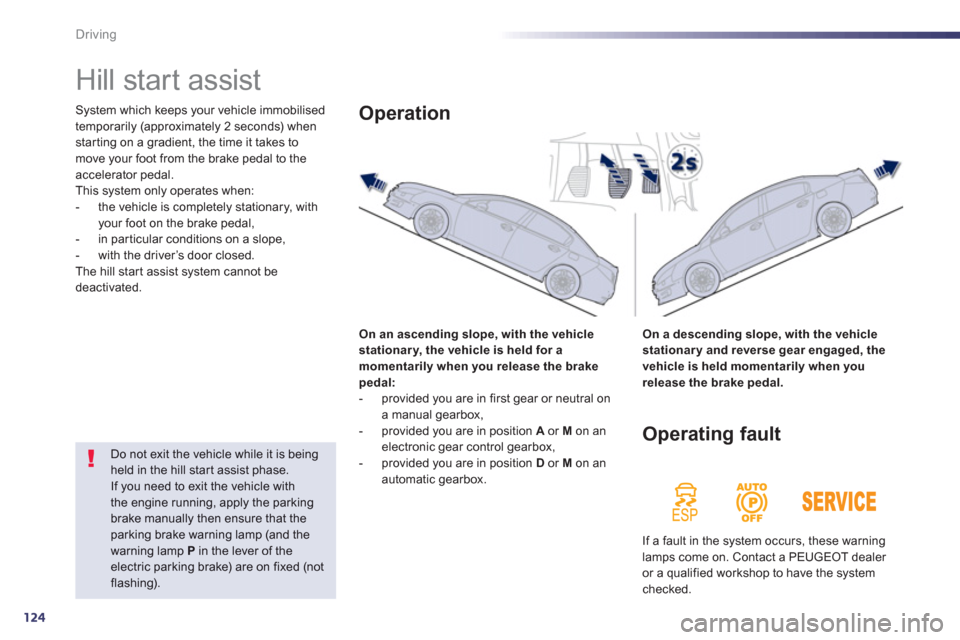
124
Driving
Hill start assist
System which keeps your vehicle immobilised
temporarily (approximately 2 seconds) whenstarting on a gradient, the time it takes to move your foot from the brake pedal to the accelerator pedal. This system only operates when:
- the vehicle is completely stationary, withyour foot on the brake pedal,
- in par ticular conditions on a slope,
- with th
e driver’s door closed.
The hill star t assist system cannot be deactivated.
On an ascendin
g slope, with the vehiclestationary, the vehicle is held for amomentarily when you release the brakepedal:
- provided you are in first gear or neutral on
a manual gearbox,
- provided you are in position A
or M
on an electronic gear control gearbox,
- provided you are in position D
or M
on an
automatic gearbox.
Operation
On a descending slope, with the vehicle
stationary and reverse gear engaged, thevehicle is held momentarily when yourelease the brake pedal.
Do not exit the vehicle while it is beingheld in the hill star t assist phase.
If you need to exit the vehicle withthe engine running, apply the parkingbrake manually then ensure that theparking brake warning lamp (and the warning lamp P
in the lever of theelectric parking brake) are on fixed (not flashing).
Operating fault
If a fault in the system occurs, these warning
lamps come on. Contact a PEUGEOT dealer
or a qualified workshop to have the systemchecked.
Page 132 of 340

130
Driving
Cruise control
speed of the vehicle at the value programmed
by the driver, without any action on the
accelerator pedal. The cruise control is switched on
manually:
it requires a minimum vehicle speed of 25 mph(40 km/h) and the engaging:
- 4th gear or higher on a manual gearbox,
- 2nd
gear or higher on an electronic gear control gearbox or automatic gearbox,
- position A
on the electronic gear control gearbox or Don the automatic gearbox.
Th
e cruise control is switched offmanuallyfor by pressing the brake or clutch pedal or
on triggering of the ESC system for safety reasons.
It is possible to exceed the programmed speed
temporarily by pressing the accelerator pedal. To return to the programmed speed, simply release the accelerator pedal.
Switching off the ignition cancels any programmed speed value. 1
.Cruise control mode selection button
2. Speed programming / programmed value decrease button 3.
Speed programming / programmed value
increase button 4.Cruise control suspension / resume button (pause)5.Cruise control off button
Steering mounted controls
The cruise control cannot, in anycircumstances, replace the need to observe speed limits, nor can it replace the need for vigilance and responsibilityon the par t of the driver.
This information also appears in the head-up display.
For more information, refer to the "Head-up display" section. The pro
grammed information is grouped
together in the instrument panel screen.
Displays in the instrument
panel
A.Cruise control on / pause indicationB.Cruise control mode selection indication
C.Programmed speed value
Page 169 of 340
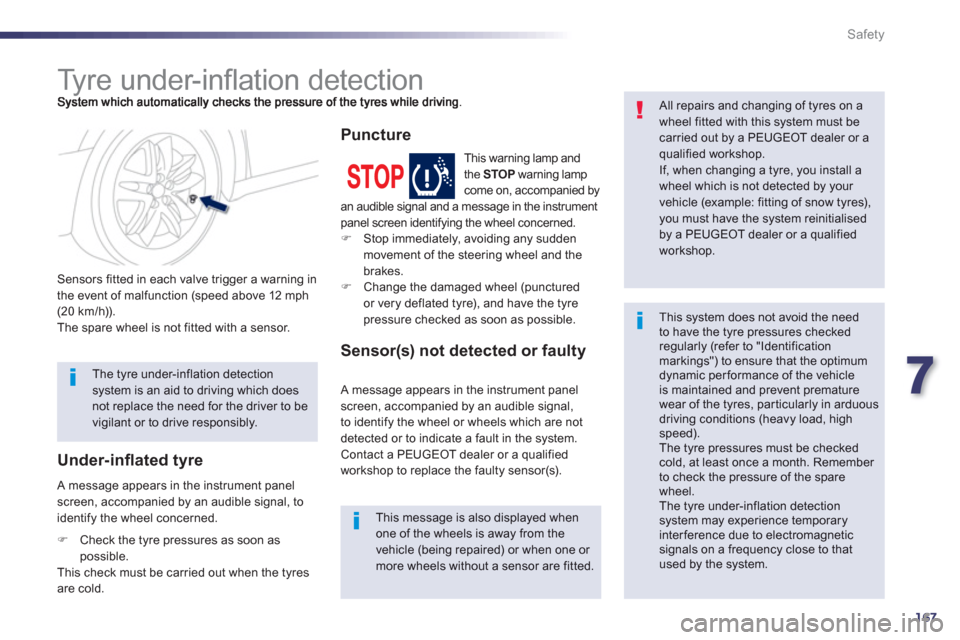
7
167
Safety
Ty r e u n d e r - i nfl ation detection
Sensors fitted in each valve trigger a warning in
the event of malfunction (speed above 12 mph (20 km/h)).
The spare wheel is not fitted with a sensor.
All repairs and changing of tyres on awheel fitted with this system must becarried out by a PEUGEOT dealer or a qualified workshop.
If, when changing a tyre, you install awheel which is not detected by your vehicle (example: fitting of snow tyres), you must have the system reinitialised
by a PEUGEOT dealer or a qualifiedworkshop.
This message is also displayed whenone of the wheels is away from thevehicle (being repaired) or when one or more wheels without a sensor are fitted.
The tyre under-inflation detectionsystem is an aid to driving which doesnot replace the need for the driver to bevigilant or to drive responsibly.
This system does not avoid the needto have the tyre pressures checkedregularly (refer to "Identification markings") to ensure that the optimumdynamic performance of the vehicleis maintained and prevent premature wear of the tyres, particularly in arduousdriving conditions (heavy load, highspeed). The tyre pressures must be checked cold, at least once a month. Remember to check the pressure of the spare wheel.
The tyre under-inflation detection system may experience temporary interference due to electromagnetic signals on a frequency close to that used by the system.
A message appears in the instrument panelscreen, accompanied by an audible signal, to
identify the wheel concerned.
Under-infl ated tyre
This warning lamp and
the STOPwarning lamp come on, accompanied by an audible signal and a message in the instrument panel screen identifying the wheel concerned. �)
Stop immediately, avoiding any sudden
movement of the steering wheel and thebrakes.�) Change the damaged wheel (punctured
or very deflated tyre), and have the tyre
pressure checked as soon as possible.
Puncture
A message appears in the instrument panel
screen, accompanied by an audible signal,
to identify the wheel or wheels which are not
detected or to indicate a fault in the system.Contact a PEUGEOT dealer or a qualifiedworkshop to replace the faulty sensor(s).
Sensor(s) not detected or faulty
�)Check the tyre pressures as soon aspossible.
This check must be carried out when the tyres are cold.
Page 170 of 340

168
Safety
Electronic Stability Programme (ESC: Electronic Stability Control) incorporating the
following systems:
- the anti-lock braking system (ABS) and the
electronic brake force distribution (EBFD),
- the emergency braking assistance,
- the anti-slip regulation (ASR) or traction
control,
- the dynamic stability control (DSC).
Electronic stability programme (ESC)
Definitions
Anti-lock braking system (ABS)
and electronic brake force
distribution
(EBFD)
This system improves the stability and
manoeuvrability of your vehicle when braking
and provides improved control in corners, in
par ticular on poor or slippery road surfaces.
The ABS prevents wheel lock in the event of emergency braking.
The electronic brake force distribution system
manages the braking pressure wheel by wheel.
Emergency braking assistance
In an emergency, this system enables you to reach the optimum braking pressure more quickly and therefore reduce the stoppingdistance.
It is triggered in relation to the speed at which
the brake pedal is pressed. This is
felt by areduction in the resistance of the pedal and an
increase in the effectiveness of the braking.
Anti-skid regulation (ASR)
The ASR system (also known as Traction Control) optimises traction in order to avoid
wheel slip by acting on the brakes of the drivingwheels and on the engine. It also improves
the directional stability of the vehicle onacceleration.
Dynamic stability control (DSC)
If there is a difference between the pathfollowed by the vehicle and that required bythe driver, the DSC monitors each wheel and
automatically acts on the brake of one or more
wheels and on the engine to return the vehicle
to the re
quired path, within the limits of the laws
of physics.
Page 171 of 340

7
169
Safety
Snow driving assistance
(Intelligent Traction Control)
Your vehicle has a system to help driving on snow: Intelligent Traction Control. This automatic system continuously checks for situations of difficult surface adhesion thatcould make it difficult to move off or makeprogress on deep fresh snow or compacted snow.
In these situations, Intelligent Traction
Controllimits the amount of wheel slip to provide the best traction and trajectory control.
In extremely severe conditions (deep snow,mud…), it can be useful to temporarilydeactivate the dynamic stability control andwheel anti-slip
systems to allow a degree of
wheel spin and so recover grip.
It is recommended that the system be
reactivated as soon as possible.
Snow t
yres are strongly recommended on sur faces offering low levels of adhesion.
Operation
Anti-lock braking system (ABS)and electronic brake force
distribution (EBFD)
In emergency braking, press very firmly without releasing the pressure.
When changing wheels (tyres and rims),make sure that these are approved for your vehicle.
Normal operation of the ABS may makeitself felt by slight vibrations of the brake pedal. When this warnin
g lamp comes on,
accompanied by an audible signal
and a message, it indicates that
there is a fault with the ABS, which could cause loss of control of the vehicle whenbraking.
When this warnin
g lamp comes on,coupled with the STOPwarning lamp,
accompanied by an audible signaland a message, it indicates that
there is a fault with the electronic brake forcedistribution (EBFD), which could cause loss of control of the vehicle when braking.
You must stop as soon as it is safe to do so.In both cases, contact a PEUGEOT dealer or a qualified workshop.